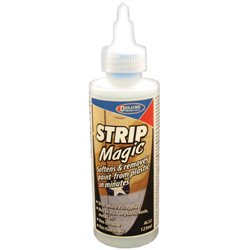Mainline Railways was a British model railway brand that operated between 1976 and 1983, introduced by Palitoy, the...
No products
Product successfully added to your shopping cart
There are 0 items in your cart. There is 1 item in your cart.
Search Tips
How do I remove paint from a model?
In the past some people have said to use oven cleaner to remove paint. I have found that this is quite an evasive method and can remove the glue from the model as well, and you end up with paint left on some pieces of the model which just ends up as a tacky mess.
There are various methods for removing small amounts of paint to complete models, acetone being a firm favourite but check on a small area first as some plastics can react with acetone and melt or deform.
There are products on the market that will remove paint such as Strip Magic from Deluxe Materials. These products have the right strength and have been fully tested to be safe on most types of kits. As such this is probably the best approach.
Click here to receive the tips weekly in your mailbox. You can unsubscribe at any time.








